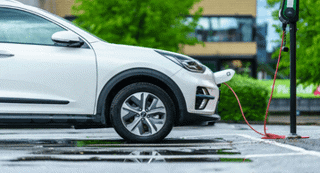The saying goes that a week is a long time in politics, but the pace of change in the fleet technology sector must surely dwarf that.
The driving force for this is the sheer amount of data created by and collected from connected technologies, such as telematics and the vehicles themselves, as well as how it is analysed including – increasingly - artificial intelligence.
Change has also been quick to happen at Geotab. Last time Fleet News caught up with the connected transportation solution company was around 18 months ago at the official opening of its automotive innovation and research hub in High Wycombe.
Since then, Aaron Jarvis has become associate VP, sales and business development, EMEA, the company has won a significant amount of new business in the UK, and it has also launched a number of new products to help fleets make the most of the data their vehicles generate.
“That office is doing really well now and we are winning lots of big contracts, which is good,” he adds.
“We now have several of the 10 largest fleets in the UK, as well as great penetration into the medium-sized fleets.
“I think the reason for that is because of the way we’ve structured the team. We’re focused really on large fleets and they have quite specific and relatively complex problems compared to a small fleet.
The saying goes that a week is a long time in politics, but the pace of change in the fleet technology sector must surely dwarf that.
The driving force for this is the sheer amount of data created by and collected from connected technologies, such as telematics and the vehicles themselves, as well as how it is analysed including – increasingly - artificial intelligence.
Change has also been quick to happen at Geotab. Last time Fleet News caught up with the connected transportation solution company was around 18 months ago at the official opening of its automotive innovation and research hub in High Wycombe.
Since then, Aaron Jarvis has become associate VP, sales and business development, EMEA, the company has won a significant amount of new business in the UK, and it has also launched a number of new products to help fleets make the most of the data their vehicles generate.
“That office is doing really well now and we are winning lots of big contracts, which is good,” he adds.
“We now have several of the 10 largest fleets in the UK, as well as great penetration into the medium-sized fleets.
“I think the reason for that is because of the way we’ve structured the team. We’re focused really on large fleets and they have quite specific and relatively complex problems compared to a small fleet.
“Our products are very flexible, we have a great rules engine, and there are lots of different things that a large fleet can use.
“We’ve combined that with a team of people with automotive engineering backgrounds, data analysis backgrounds, and they can sit down with the customer and they can solve the problem.
“We’ve also invested really heavily in having better – or more- relationships with OEMs than our competitors, so we now cover about 80% of the market in terms of OEMs.”
Manufacturer agreements
Geotab has struck agreements with a number of manufacturers including Volkswagen Group, BMW-Mini Group, Renault, Dacia, Ford, all Stellantis Group brands and Mercedes-Benz to integrate data generated by those vehicles in its MyGeotab platform via an application programming interface (API), as well as from its own telematics device.
Jarvis says this means it is now “relatively easy” to get large fleets on-board. “If you imagine five years ago, to sign up an 8,000 vehicle fleet you have to visit every vehicle to install telematics hardware, and if that fleet has an incumbent telematics supplier, that’s quite a big cost of change,” he says.
“Working with the OEMs, we can just turn on the connectivity overnight. So now we’ve got a really good understanding of what OEMs offer, the use cases that connectivity solves.
“We’ve recently done one large fleet which mainly used Stellantis vehicles, and we switched on 50% of their fleet on day one, while we retrofit the rest of the vehicles.”
The platform is able to streamline data collection and conversion, offering advanced data analysis and actional insights while ensuring data privacy and security.
The integration ensures that all data is transmitted and stored within a secure Geotab database so that it is under the control of the fleet owner.
Two of the major focuses for fleets using Geotab’s technology are safety and sustainability, and at its Mobility Connect conference in Milan in October the company announced a number of new solutions for its MyGeotab platform: sustainability centre, gas emissions calculation method, electric vehicle suitability assessment (EVSA) and EV charge monitoring.
Jarvis says its Sustainability Centre provides actionable insights and pinpoints opportunities for emissions reduction to support fuel and energy savings and performance optimisation.
It allows fleets to track emissions and the potential to reduce them using idling reduction and electrification, monitor avoided tailpipe emissions, emissions generated and fuel economy.
It also identifies emission reduction opportunities and explore electrification options, using its EVSA, which can also identify suitable EVs.
Although elecrificaiton is a key focus for Geotab and its customers, Jarvis says it tends to take a broader view on sustainability as a whole when working with a fleet.
“That means driving down the emissions from the vehicles they have, making sure they are able to meet their science-based targets, helping them with their ESG reporting, all those types of thing,” he adds.
“An important part of that is managing the data. Fleet managers often get too much.
“You can sit down with a fleet manager that’s looking at sustainability, and they’ve got a fuel provider giving them fuel card reports.
“Maybe there’s a middle man between them and the fuel provider that’s trying to add value by then also giving some fuel reports or some insight on that fuel report, then maybe they’ve got data from a home EV charger, and then all of a sudden someone who was managing 100 vans three years ago has got 100 vans, fuel reports, EV charging data and so on to deal with.
“Where we’re focused is trying to boil all that down into some easy to understand insights through our new tools.”
Generative AI analytics
To further advance this, the company is also using generative AI analytics in its Geotab Ace service.
“AI is a big buzz word at the moment, and there’s definitely a growing demand for AI-based insights to reduce the fleet manager’s workload,” says Jarvis.
“Things that would take 200 hours to calculate for a fleet team is now just a written question through Geotab Ace,” says Jarvis.
“For example, you could ask it which of your vehicles could transition to EV today, and it will come back instantly with an answer, or you could ask it to identify who your riskiest drivers are, and it will show you that.”
Geotab’s Safety Centre helps fleet managers uncover and manage fleet performance risks, allowing them manage drivers and identify any training needs based on objective data, predictive collision analytics and benchmarking against other fleets.
Accurate benchmarking is possible due to the sheer number of drivers which use Geotab telematics, says Jarvis.
“We have a significant volume of data of drivers in the UK, but we are very strict on how we can aggregate it.
“You need to have lots of different customers: it’s fine having one big customer, but you can’t use that data for anything because it’s clear where that data is from.
“You can’t anonymise it, which is essential for data privacy, and we spend a lot of time making sure the data is secure but also helping fleet teams explain to their business that it is secure.”
He says the benchmarking concept allows Geotab to move away from the traditional approach of identifying risk and use machine learners to detect trends and the potential of a collision before they happen.
“Where we’re being quite different – and I think fleets are finding it very useful – is that instead of taking the traditional approach of saying ‘Aaron’s like a six-out-of-10 driver’, we are using big data to get really specific about risk,” adds Jarvis.
“Using our benchmarking concept that we do with everything, we can compare things that Aaron is doing to things that have happened in vehicles which have had a crash to say ‘Aaron has a 25% probability of crashing in his next 100,000 miles’.
“Using machine learning, we can look for similarities between drivers and follow them over time.
“The worst driver in your fleet is your worst driver and maybe they’ve got a 50% chance of crashing.
“But what happens when one of your best drivers suddenly has a bad period? Using traditional methods like licence checks and speeding endorsements, they may still be classed as a good driver, but we can proactively look at the risk of a driver and you’re suddenly using this insight to be a good employer.
“We’re seeing more demand for tools to help fleets identify and manage those drivers.”
Login to continue reading.
This article is premium content. To view, please register for free or sign in to read it.
























Login to comment
Comments
No comments have been made yet.